Decor
Make a Bird Nest Easy
Build a cozy bird nest with simple materials and steps; discover how to create a charming abode for feathered friends.

Crafting a bird nest can be a satisfying project with the right materials and method. Start by gathering Spanish moss, sticks, and hot glue. Prepare your workspace with protective paper and proper ventilation. Shape sturdy twigs into a circular base, securing them for stability. Layer with Spanish moss, grass, and feathers for comfort. Adhere materials together with spray adhesive, ensuring even application. Add decorative elements like moss and feathers with hot glue. Consider seasonal touches for a festive look. Display your DIY nest creatively in your home. Enhance with bluebird eggs for an authentic touch. Explore our steps to easily create a charming bird abode.
Key Takeaways
- Select sturdy twigs for the base.
- Layer with Spanish moss and grass.
- Use hot glue for secure bonding.
- Add decorative moss and feathers.
- Display creatively in home decor.
Gather Nesting Supplies
Let's start by gathering the necessary supplies for crafting a bird nest. For our DIY Bird Nest project, we'll need natural materials like Spanish moss to provide a cozy and authentic feel. Additionally, sticks and green moss can be collected to add texture and visual interest to the nest. To secure these materials in place, it's advisable to have hot glue on hand, which will help guarantee a sturdy construction.
In addition to natural elements, essential crafting supplies such as spray adhesive, scissors, and wire cutters should be purchased. These tools will aid in the assembly process and make it easier to manipulate the materials. Bundles of nesting material and grapevine wreaths can serve as the base for our bird nest, providing a foundation for the creative process.
To add realistic details to the nest, consider acquiring craft eggs and feathers. These items will enhance the overall appearance of the nest and make it more visually appealing.
With these supplies in hand, we're ready to commence our DIY Bird Nest crafting journey.
Prepare Workspace

Covering our workspace with craft paper or newspaper is essential to protect surfaces from stickiness and glue during the DIY Bird Nest crafting process. This simple step helps maintain cleanliness and prevents any unwanted mess.
Additionally, when working with crafting materials like spray adhesive, it's important to make sure proper ventilation by working in a well-ventilated area or using a fan to disperse any fumes. Safety should always come first when engaging in any crafting activity.
Before diving into the crafting process, it's important to organize all necessary materials such as nesting supplies, Spanish moss, green moss, sticks, and leaves. Having these items readily available will streamline the crafting process and prevent unnecessary delays.
Shape Nest Base

When shaping the nest base, it's crucial to choose sturdy twigs and arrange them in a circular pattern. This circular arrangement provides a strong foundation for the nest and helps create a cozy space for the eggs.
Select Sturdy Twigs
Choosing robust twigs is vital to establish a strong foundation for the bird nest. Sturdy twigs provide the necessary support and structure for the nest to withstand the weight of nesting materials and eggs. When selecting twigs, opt for ones that are similar in size and length to guarantee uniformity and stability in the nest's base.
These twigs should be arranged in a circular pattern to create a solid foundation. It's important to secure the twigs together using natural materials like twine or thin wire to enhance durability and longevity.
Arrange in Circular Pattern
To create a sturdy and authentic bird nest, we start by shaping the base in a circular pattern that mimics a bird's natural nesting structure. This circular shape provides a cozy and protective environment, similar to how birds create their nests in the wild.
Using natural materials such as Spanish moss and pine straw helps achieve a realistic and authentic look. By weaving sticks into the moss base, we add texture and stability to the nest construction, guaranteeing it can withstand various weather conditions.
The circular pattern not only enhances the nest's structural integrity but also allows for easy placement of decorative elements like eggs or feathers in the center. This arrangement adds to the aesthetic appeal of the nest, making it more visually appealing and attractive to birds.
Emulating the design of natural bird nests with a circular shape and incorporating natural materials guarantees that our handmade bird nest closely resembles those found in nature.
Layer Nesting Material

Layering nesting materials is crucial for creating a comfortable and secure environment for bird eggs and chicks. To start, lay a foundation of Spanish moss at the bottom of the nest to provide a sturdy base. This DIY moss will help support the weight of the eggs and chicks while offering a natural feel.
On top of the moss, add dried grass or straw for insulation and comfort, guaranteeing the nest retains warmth. Use small twigs or sticks to construct a framework that gives the nest structure and stability. Incorporate soft materials like feathers or down to offer cushioning for the delicate eggs and young chicks.
Adhere Materials Together

Let's secure the natural materials together by using spray adhesive to create a sturdy bird nest structure. Spray adhesive is a handy tool for bonding components like Spanish moss, green moss, sticks, and leaves in a bird nest. It aids in holding these materials in place, ensuring a cohesive and robust nest. When applying the spray adhesive, it's important to maintain proper ventilation to avoid inhaling fumes, so working in a well-ventilated area is recommended. Evenly applying the adhesive to the natural materials is vital to prevent any gaps or loose sections within the nest. One advantage of using spray adhesive is its quick drying time, enabling you to progress efficiently with building the nest. Check out the table below for a quick reference on adhering materials together for your bird nest.
| Material | How to Apply Spray Adhesive | Tips for Adhesion |
|---|---|---|
| Spanish Moss | Lightly spray over the moss | Ensure full coverage |
| Green Moss | Apply adhesive underneath | Press firmly to secure |
| Sticks | Spray along the stick's length | Allow time to set properly |
| Leaves | Spray adhesive on the back | Layer leaves for stability |
Add Decorative Touches

Enhancing the bird nest with decorative elements like moss, feathers, and branches adds charm and personality to the overall design. To achieve this, consider using hot glue to attach embellishments such as plastic eggs or seasonal flowers.
For a vintage touch, you can paint and distress the eggs before nestling them within the materials. To infuse a hint of whimsy, incorporate small bird figurines or delicate butterflies into the arrangement. Experimenting with various textures and colors allows you to create a visually appealing and personalized bird nest that reflects your unique style.
Remember to balance the decorative elements within the nest to maintain a cohesive and harmonious look. By carefully placing each item and ensuring they're securely attached with hot glue, you can prevent them from shifting or falling out of place. This attention to detail will elevate the aesthetics of the bird nest and showcase your creativity in a delightful manner.
Display Your Bird Nest

When it comes to showcasing your bird nest, there are various creative ways to display these natural treasures.
From using them as a centerpiece to hanging them on a door or window, the options are endless.
Highlighting bird nests in your decor can bring a touch of the outdoors inside your home.
Bird Nest Showcase
To showcase your bird nest effectively, consider placing it under a cloche for a charming spring decor piece. Adding small Easter eggs or seasonal flowers can enhance the beauty of your bird nest display, creating a delightful focal point in your home decor.
For a whimsical touch, incorporate your bird nest into vintage books or wreaths, infusing a sense of nostalgia into your living space. To further embellish your bird nest showcase, consider adding crowns, lavender, or delicate flower petals, elevating the visual appeal.
Guests admiring your bird nest display can be intrigued by the German legend of finding a bird nest in a Christmas tree, believed to bring good fortune. Sharing this folklore can add an interesting conversation piece to your home decor.
Creative Nest Display
Let's spruce up your bird nest display by showcasing it under a charming cloche for an elegant touch. Adding small decorative elements like Easter eggs or flowers can enhance the overall appeal of your nest display. For a unique and whimsical look, consider placing your bird nest in a vintage book or flower pot.
Bird nests can be incorporated into seasonal decor by adding elements like pumpkins for fall or Christmas ornaments for the holidays, creating a festive and inviting atmosphere. This versatile decor piece can bring a touch of nature into your home throughout the year.
In Germany, it's a tradition to find a bird nest in a Christmas tree, believed to bring good luck and friendship to the household. By incorporating this tradition into your seasonal decor, you can add a meaningful and symbolic element to your display.
Get creative with your nest display and explore different ways to incorporate bird nests into your seasonal decorations.
Highlighting Bird Nests
Highlighting bird nests can enhance your home decor with a touch of nature-inspired beauty. These charming creations can serve as a captivating centerpiece or a delightful hanging decor piece, bringing a sense of the outdoors into your living space.
Bird nests offer a versatile alternative to traditional wreaths, allowing you to infuse a unique element into your Spring home ambiance. Consider styling bird nests on doors, windows, old shutters, or garden gates to create a natural and inviting atmosphere.
Incorporating bird nests into a Spring tablescape alongside floral arrangements and Easter decor can enhance the overall aesthetic of your home. Their intricate designs and earthy tones add a rustic yet elegant charm to any room, making them a versatile accent for various decor styles.
Consider Seasonal Embellishments

We can enhance the charm of the bird nest by adding seasonal embellishments like plastic Easter eggs or mini pumpkins. These additions bring a touch of festivity to the nest, making it a delightful sight in your home decor. Consider incorporating crowns, lavender, or flower petals into the bird nest for a seasonal beauty that captures the essence of each time of year. To help visualize the possibilities, take a look at the following table showcasing some ideas for seasonal embellishments:
| Season | Embellishments | Description |
|---|---|---|
| Spring | Plastic Easter eggs | Adds a pop of color |
| Lavender | Infuses a fresh scent | |
| Flower petals | Brings a touch of nature | |
| Summer | Seashells | Creates a beachy vibe |
| Sunglasses | Adds a playful element |
Enjoy Your DIY Nest

Enhancing your DIY bird nest with natural materials and decorative elements creates a charming and realistic display for your home decor. Utilizing items like Spanish moss, sticks, and pine straw can help in achieving an authentic look for your bird nest. By securing the moss with spray glue and weaving in sticks for structural support, you can shape the nest into a round form. Drying the glue with a heat gun guarantees durability, making your DIY nest last longer.
To add an extra touch of charm, consider displaying the nest with decorative elements such as bluebird eggs on a DIY stand. This not only enhances the aesthetic appeal but also adds a touch of creativity to your creation. Exploring seasonal and holiday crafting opportunities can offer new ways to enhance your DIY bird nest projects, providing versatility and a fresh look to your home decor.
Enjoy the process of creating and displaying your DIY bird nest, adding a personalized touch to your living space.
Frequently Asked Questions
How to Make a Simple Bird Nest?
To guarantee a simple bird nest, gather materials like twigs, grass, and leaves. Use a small bowl as a mold for shaping. Secure the materials with hot glue or wire.
Add decorative elements such as feathers or moss for flair. Display the nest on a tabletop or hang it for a rustic look.
This process guarantees a quick and easy way to create a cozy nest for your feathered friends.
How to Build a Nest for Kids?
Building a nest for kids can be a fun and educational activity. By using simple materials like paper, twigs, and string, children can create their own bird nests.
Encourage creativity by letting kids choose colors and decorations. Teach them about the importance of bird nests in nature and discuss different bird species and their nesting habits.
Make the activity interactive by going on a nature walk to collect materials. This hands-on approach fosters learning and creativity in children.
How to Make a Bird Nest With Cardboard?
To make a bird nest with cardboard, follow these steps:
Cut strips and form a circular base. Layer more strips vertically for the walls, securing them with hot glue or tape. Fill the nest with shredded paper or twigs. Customize with paint, moss, or feathers for realism.
This simple project provides a fun and educational way to learn about birds and their habitats.
Follow these steps for a successful and enjoyable crafting experience.
How Do You Make a Wild Baby Bird Nest?
We don't recommend making a nest for wild baby birds, as they require specific materials and locations provided by their parents in their natural habitats.
It's important not to disturb these nests, typically made from twigs, leaves, grass, and feathers.
Wild baby birds are best left to be cared for by their parents.
If you encounter a wild baby bird in need of assistance, contacting a wildlife rehabilitator is the best course of action for their proper care.
Conclusion
To sum up, creating a bird nest can be a simple and rewarding DIY project. By following the steps outlined above and adding your own personal touches, you can design a beautiful and functional nest for your feathered friends.
Just like birds carefully construct their nests to provide safety and comfort for their young, you too can create a cozy haven that will bring joy and beauty to your outdoor space.
Happy nesting!
- About the Author
- Latest Posts
Introducing Ron, the home decor aficionado at ByRetreat, whose passion for creating beautiful and inviting spaces is at the heart of his work. With his deep knowledge of home decor and his innate sense of style, Ron brings a wealth of expertise and a keen eye for detail to the ByRetreat team.
Ron’s love for home decor goes beyond aesthetics; he understands that our surroundings play a significant role in our overall well-being and productivity. With this in mind, Ron is dedicated to transforming remote workspaces into havens of comfort, functionality, and beauty.
Decor
Master Antiquing With Chalk Paint in 5 Steps
Start your journey to mastering antiquing with chalk paint in 5 steps and transform your furniture into vintage treasures.
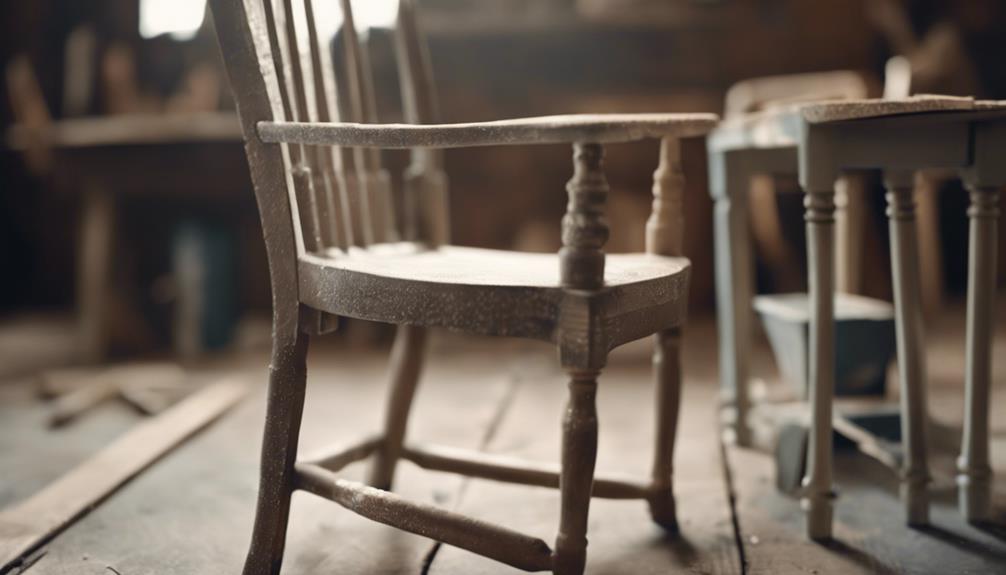
Master antiquing with chalk paint in 5 steps involves thorough surface cleaning, applying chalk paint in thin coats, distressing for a vintage look, sealing with a wax or polyurethane finish, and exploring different distressing techniques. Prepare by cleaning and sanding the surface, then choose high-quality paint and brushes for application. Experiment with dry and wet distressing, and seal the finish to protect against chipping and fading. For unique finishes, mix distressing methods and select the right sealant based on desired outcome. Mastering chalk paint antiquing takes practice and attention to detail, ensuring a beautifully aged furniture look.
Key Takeaways
- Choose high-quality chalk paint for best results.
- Apply thin, even coats for a smooth finish.
- Experiment with distressing techniques like dry or wet distress.
- Seal the finish with wax or polyurethane for durability.
- Practice and refine distressing skills for a masterful antique look.
Preparation
Before distressing furniture with chalk paint, we make sure to thoroughly clean the surface and lightly sand any rough spots for a smoother finish. This step is essential in achieving a professional-looking result.
Cleaning the furniture surface with White Lightning or TSP Degreaser helps remove any dirt, grease, or other contaminants that could interfere with the adhesion of the chalk paint. Using a lint-free cloth ensures that the surface is free of any residue that could affect the paint application.
Additionally, lightly sanding the furniture helps create a clean and smooth surface for the chalk paint to adhere to evenly. This process also helps remove any existing imperfections, ensuring a flawless final result.
Proper preparation sets the foundation for successful distressing with chalk paint, allowing for a more authentic and aged appearance.
After distressing, sealing the piece with a clear wax coat will protect the finish and enhance the overall look of the furniture.
Applying Chalk Paint
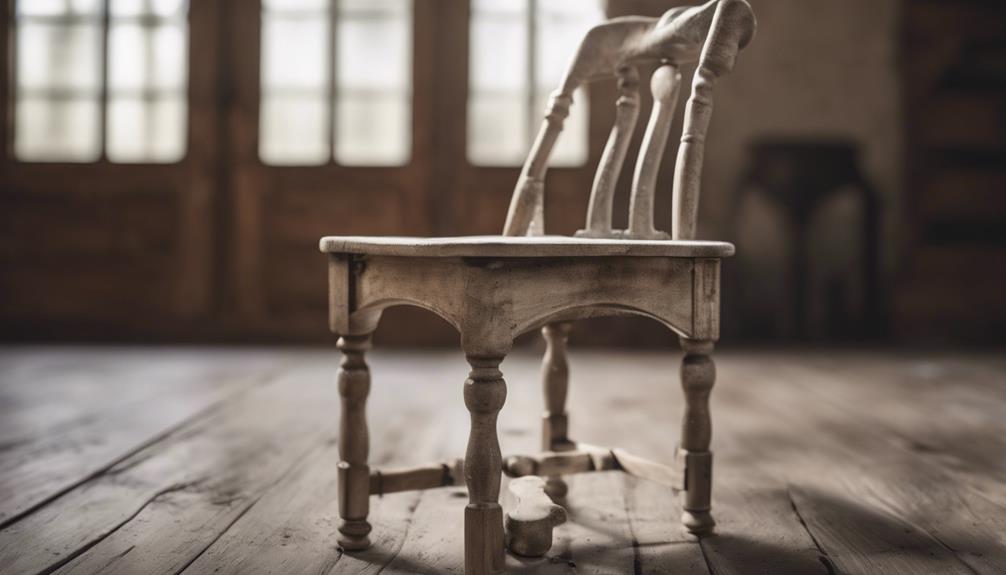
To achieve a professional finish with chalk paint, we recommend selecting a high-quality paint suitable for the specific furniture type.
When applying chalk paint, it's important to do so in thin coats to guarantee even application. Utilizing chalk paint brushes can help achieve better control and coverage.
It's vital to allow each coat of chalk paint to dry completely before applying the next one. This process helps prevent smudging and promotes a consistent finish.
Additionally, when starting a project, make sure you have enough chalk paint, typically a quart for larger pieces, to maintain color consistency throughout the furniture item.
Distressing Techniques
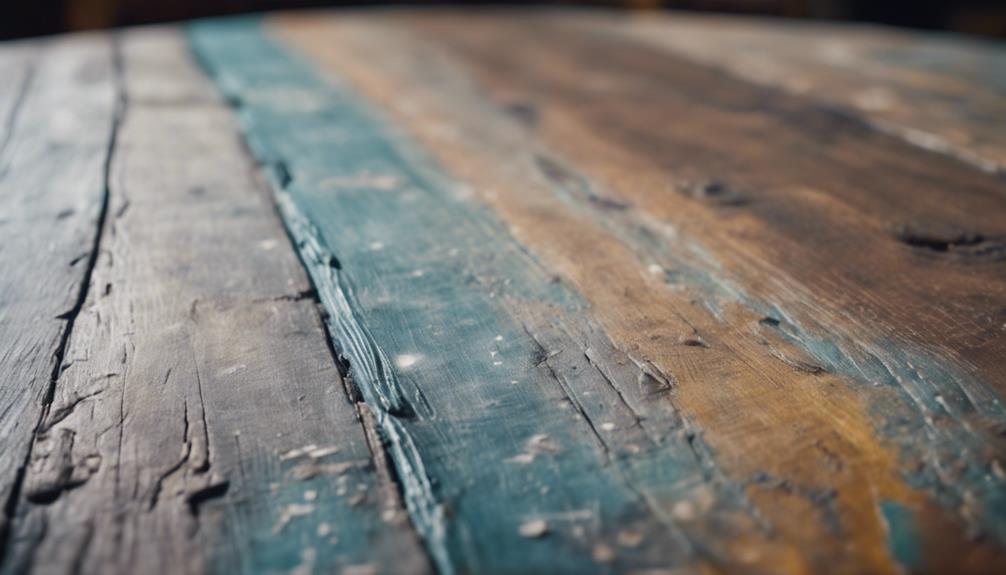
We can achieve various vintage looks by using different distressing techniques with chalk paint. Dry distress involves lightly sanding the chalk paint to reveal the underlying layers, creating a weathered appearance reminiscent of aged furniture.
On the other hand, wet distress requires wiping the chalk paint with a damp cloth to achieve a more natural, worn look. Wax distress, also known as the resist technique, utilizes wax as a barrier to create a subtle distressed effect on the furniture, adding depth and character to the piece.
Each distressing method offers a unique finish, allowing for experimentation and customization to achieve an authentic antique appearance. By trying out different distressing techniques, individuals can discover the method that best suits their desired vintage look.
Whether it's through sanding, wax resist, wet distress, or a combination of these methods, chalk paint provides a versatile medium for creating distinctive and aged finishes on furniture pieces.
Sealing the Finish

For achieving a durable and long-lasting distressed finish on furniture painted with chalk paint, selecting a high-quality clear wax or polyurethane sealant is essential. Applying a protective layer of sealant is vital to preserve the distressed look and prevent chipping or fading of the paint. It is recommended to apply the sealant in even coats to guarantee a smooth and lasting finish. Here is a comparison table to help you choose between wax and polyurethane sealants for your distressed furniture:
| Criteria | Wax Sealant | Polyurethane Sealant |
|---|---|---|
| Finish | Matte or Satin Finish | Glossy or Satin Finish |
| Durability | Requires Reapplication Over Time | Long-lasting and Durable |
| Application Ease | Easy to Apply, Buffing Required | Requires Thorough Application |
Both wax and polyurethane sealants offer protection and enhancement to your chalk-painted distressed furniture. Select the one that best suits your desired finish and maintenance preferences.
Chalk Paint Distressing Tips

Let's explore effective techniques for distressing chalk paint to achieve a vintage and worn look on furniture surfaces.
When aiming for a customized distressed finish, there are various distressing methods to choose from. Dry distress involves lightly sanding the chalk paint to reveal the base color underneath, offering a classic vintage appearance.
On the other hand, the wet distress technique includes wiping off the chalk paint with a damp cloth to create a natural worn effect.
For a more subtle distressed finish, consider using the wax distress or resist technique by applying wax to protect certain areas from paint.
Remember to protect the paint and preserve the finish by sealing distressed furniture with wax or polyurethane.
Frequently Asked Questions
How to Get an Antique Look With Chalk Paint?
To achieve an antique look with chalk paint, consider distressing techniques like dry distressing, wet distressing, or wax distress.
Dry distressing involves light sanding for a vintage appearance.
Wet distressing requires wiping the paint with a damp cloth for a natural worn look.
Wax distress, or resist technique, can create a subtle distressed effect on furniture.
Sealing the distressed piece with clear wax or polyurethane is essential to protect the finish and maintain the antique aesthetic.
How to Make Furniture Look Distressed With Chalk Paint?
To make furniture look distressed with chalk paint, we can use various techniques. Dry distressing involves lightly sanding the surface to reveal the base layer, creating a vintage effect.
Wet distressing entails wiping the paint with a damp cloth to expose the underlying color, achieving a natural worn look.
Wax distressing, known as the resist technique, uses wax to create a subtle distressed effect.
These methods offer unique ways to customize and achieve a distressed look with chalk paint.
How Do You Chalk Paint Step by Step?
We begin chalk painting by cleaning and lightly sanding the furniture surface.
Next, select a high-quality chalk paint and apply it in thin, even coats.
Explore different distressing methods such as dry, wet, or wax distress.
Finally, seal the distressed furniture with clear wax or polyurethane for protection.
Following these steps attentively guarantees a successful chalk painting project with a beautifully antiqued finish.
Do I Distress or Wax First?
We recommend distressing before waxing when working with chalk paint for an authentic aged appearance. Distressing creates texture and depth, enhancing the final antique effect once sealed with wax.
Applying wax over distressed areas not only protects the finish but also accentuates the distressed look. Waxing before distressing can complicate the process as the wax may interfere with sanding.
Distressing first allows for better control over the furniture's final appearance.
Conclusion
To sum up, mastering antiquing with chalk paint is a fulfilling process that can transform ordinary furniture into stunning pieces with character and charm.
As the saying goes, 'A piece of furniture is like a blank canvas waiting to be brought to life.'
By following these 5 steps, you can discover the full potential of chalk paint and create unique and beautiful pieces that will stand the test of time.
Happy antiquing!
- About the Author
- Latest Posts
Introducing Ron, the home decor aficionado at ByRetreat, whose passion for creating beautiful and inviting spaces is at the heart of his work. With his deep knowledge of home decor and his innate sense of style, Ron brings a wealth of expertise and a keen eye for detail to the ByRetreat team.
Ron’s love for home decor goes beyond aesthetics; he understands that our surroundings play a significant role in our overall well-being and productivity. With this in mind, Ron is dedicated to transforming remote workspaces into havens of comfort, functionality, and beauty.
Decor
10 Steps to Painting a Plastic Frame
Uncover professional tips for transforming plastic frames with paint, ensuring a flawless finish and lasting results.
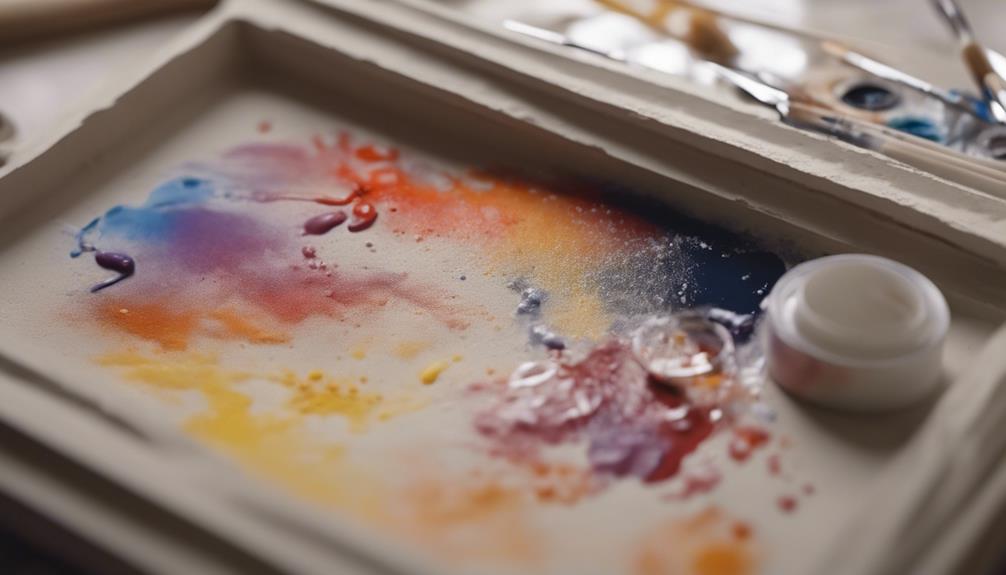
To paint a plastic frame effectively, start by selecting polypropylene or polyethylene frames. Clean thoroughly and lightly sand before applying a suitable primer. Use rubbing alcohol for a smooth finish, then mask off areas and apply even coats of paint with proper drying time. Add creative touches and seal with polyurethane for protection. This process guarantees a professional-looking result that lasts.
Key Takeaways
- Select plastic frames suitable for painting, avoiding PVC or polystyrene.
- Thoroughly clean and lightly sand the frame for adhesion.
- Apply a plastic-specific primer evenly after surface prep.
- Use painter's tape for clean lines and masking off.
- Seal with polyurethane for protection and finish longevity.
Selecting the Right Plastic Frame
When selecting a plastic frame for painting, make sure it's made of suitable materials like polypropylene or polyethylene for better paint adhesion. Different plastics have varying levels of compatibility with paint, so it's important to choose the right type to achieve best results.
Avoid using frames made of polyvinyl chloride (PVC) or polystyrene, as these materials may not allow the paint to adhere effectively, leading to peeling or flaking over time.
Certain types of paint may also work better with specific plastic frames. Checking the manufacturer's recommendations for the frame can provide valuable insights into which paints are most suitable for that particular material.
Opting for plastic frames specifically designed for painting can ensure a smoother process and a more professional finish.
Cleaning and Sanding the Surface

How should we prepare the plastic frame surface before painting to guarantee excellent adhesion and a smooth finish? To guarantee a successful paint job, follow these steps:
- Cleaning:
Begin by thoroughly cleaning the plastic frame to remove any dirt, dust, or grime. This step is vital as any impurities on the surface can affect the adhesion of the paint.
- Sanding:
Lightly sand the surface of the plastic frame to create a rough texture. This roughness provides a better grip for the paint, allowing it to adhere more effectively and prevent peeling or chipping.
- Primer:
Consider applying a suitable primer after cleaning and sanding the frame. A primer helps the paint adhere better to the surface and can also aid in achieving a smoother finish.
- Masking:
Before painting, make sure to mask off any areas of the frame that you don't want to paint. This step ensures clean and precise lines, giving your project a professional look.
Wiping Down With Rubbing Alcohol

We recommend wiping down the plastic frame with rubbing alcohol to guarantee proper adhesion and a smooth finish before painting. Rubbing alcohol plays a vital role in preparing the plastic surface for painting by effectively removing any dirt, oils, or residue that could hinder paint adhesion. This step ensures that the paint adheres well to the plastic surface, reducing the risk of peeling or flaking over time. The quick evaporation of rubbing alcohol leaves behind a clean and dry surface, ready for the next steps in the painting process.
To illustrate the importance of this step, let's take a look at the table below:
| Benefits of Wiping Down with Rubbing Alcohol |
|---|
| Removes dirt, oils, and residue from the plastic surface |
| Enhances paint adhesion for a smoother finish |
| Quick evaporation leaves a clean surface ready for painting |
| Prevents peeling or flaking of the paint over time |
| Effective and efficient preparation before priming or painting |
Masking Off Areas for Painting

When masking off areas for painting a plastic frame, it's essential to use painter's tape to guarantee clean lines and edges.
Make sure to press down firmly on the tape to avoid any paint bleeding onto unwanted areas.
Carefully mask off intricate details or sensitive parts to achieve a professional finish.
Taping off Edges
To achieve clean and precise lines in your painting, carefully use painter's tape to mask off areas of the plastic frame that you don't want to paint.
Here are some essential steps to follow when taping off edges:
- Prepare the Surface: Make sure the edges are clean and dry before applying the tape to promote adhesion and prevent paint seepage.
- Apply the Tape: Gently press the painter's tape along the edges of the areas you want to protect, ensuring it adheres firmly to the surface.
- Seal the Edges: Run your finger along the edge of the tape to secure it tightly to the plastic frame and prevent any paint from bleeding through.
- Double-Check: Before painting, inspect the taped-off areas to confirm that the edges are properly sealed and that there are no gaps where paint could seep under the tape.
Taking the time to tape off the edges meticulously will result in a professional and polished finish for your painted plastic frame.
Covering Sensitive Parts
Cover delicate parts like glass or hardware with masking paper or plastic before painting the plastic frame to protect them from unwanted paint.
When working on plastic frames, it's important to use painter's tape to mask off areas that shouldn't be painted. Make sure the painter's tape is firmly pressed down to create a tight seal and prevent any paint from seeping through.
In addition to using painter's tape, consider covering sensitive components such as glass or hardware with masking paper to safeguard them during the painting process. Taking the time to accurately mask off these areas will result in clean and precise paint lines, contributing to a professional-looking finish on your plastic frame.
Properly covering these sensitive parts is essential in achieving a polished and refined appearance for your painted plastic frame.
Applying a Suitable Primer
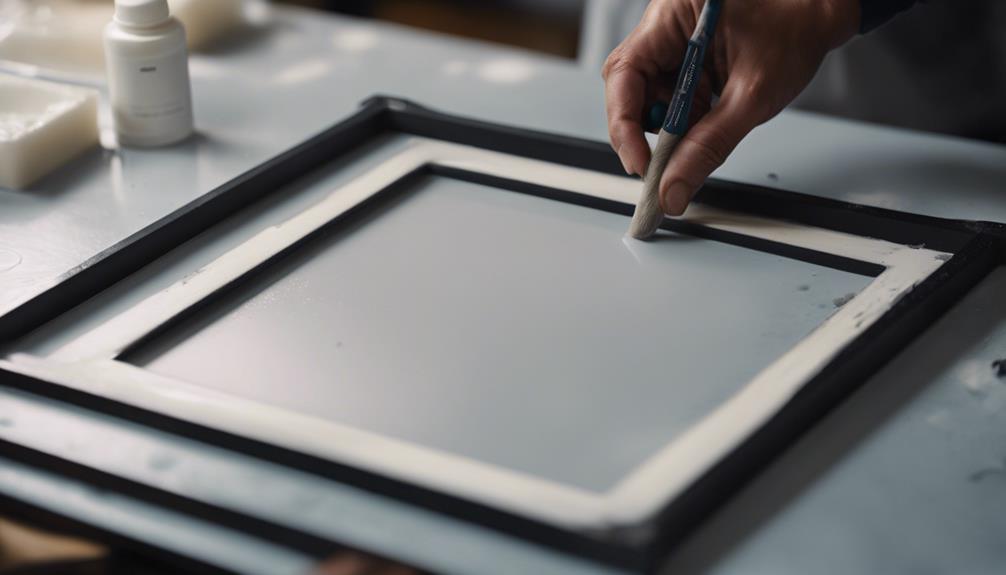
Let's kick off this step by prepping the plastic frame with a primer that's compatible with plastic surfaces. Here's what you need to know:
- Choose the Right Primer: Select a primer specifically designed for plastic frames to guarantee proper adhesion.
- Apply Evenly: Use smooth, consistent strokes to apply the primer evenly over the entire surface of the frame.
- Allow Sufficient Drying Time: Let the primer dry completely as per the manufacturer's instructions before proceeding with the next steps.
- Ensure Complete Coverage: Make sure the primer covers the plastic frame entirely to establish a strong base for the paint.
Using Appropriate Paint for Plastic

After preparing the plastic frame with a suitable primer, the next crucial step involves selecting the right paint specifically formulated for plastic surfaces.
When painting a plastic picture frame, it's vital to choose a type of paint that's designed to adhere to plastic materials. Using regular paints may result in poor adhesion, leading to peeling or chipping off easily. To guarantee a durable and long-lasting finish, opt for acrylic paint or other paints labeled for plastic surfaces. These specialized paints are formulated to bond effectively with plastic, preventing flaking and ensuring a smooth application.
Whether you prefer spray paints for a quick and even coverage or brush-on paints for more detailed work, selecting the appropriate paint for your plastic picture frame is key to achieving a professional-looking result.
Applying Even Coats of Paint
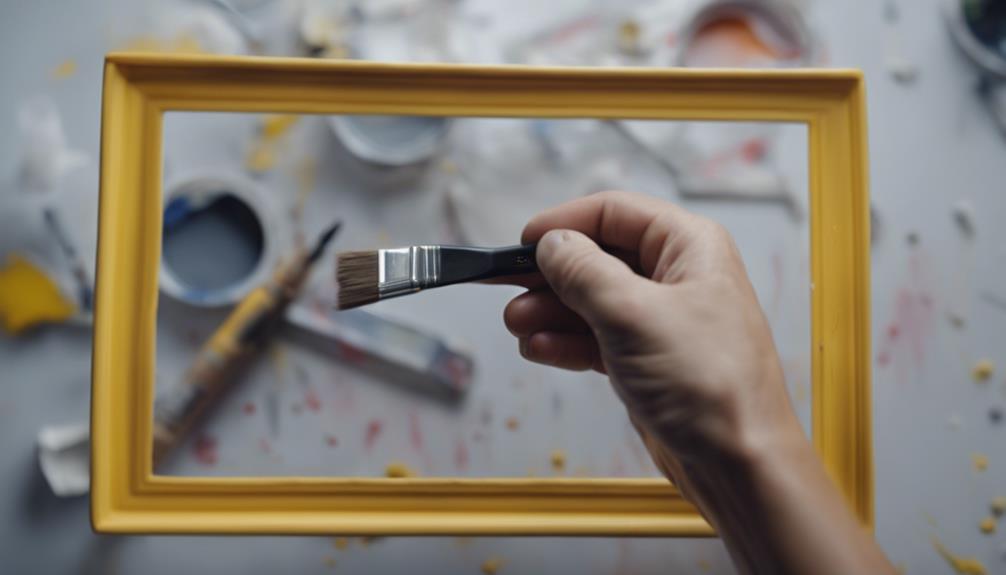
To achieve a smooth and professional finish on a plastic frame, it's essential to apply even coats of paint. When painting picture frames, following these guidelines guarantees a flawless result:
- Apply Thin and Even Coats: Each layer of paint should be applied thinly and evenly across the frame to prevent drips or uneven coverage.
- Allow Proper Drying Time: It's vital to let each coat dry before applying the next one. This helps the paint set correctly and adhere well to the plastic surface.
- Opt for Light Coats: Applying multiple light coats is preferable to a single heavy coat. This technique prevents clumping or streaking, resulting in a more uniform finish.
- Maintain Consistency: Consistency in paint application is key to achieving a uniform color and texture throughout the frame. Make sure to follow a systematic approach to ensure a professional-looking outcome.
Allowing Each Coat to Dry
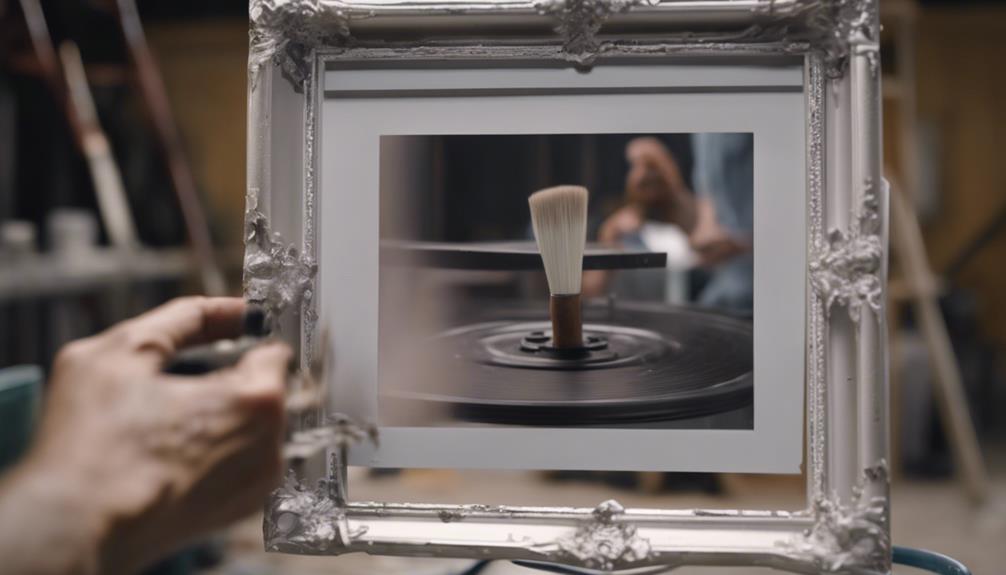
Guaranteeing that each coat of paint is thoroughly dried is a critical step in achieving a flawless finish on a plastic frame. By allowing sufficient drying time between coats, we can prevent potential issues like smudges, drips, or uneven application.
It's vital to follow the recommended drying times based on the type of paint utilized to secure the best results.
Patience for Drying Times
For best results, guaranteeing each coat of paint on the plastic frame dries thoroughly before applying the next coat is essential. Here are some key points to keep in mind:
- Prevent Smudging and Streaking: Allowing each coat to dry completely helps prevent unwanted smudges or streaks in the paint job.
- Refer to Manufacturer's Instructions: Drying times can vary depending on the type of paint used. Always refer to the manufacturer's instructions for specific guidance on drying times.
- Avoid Rushing the Process: Rushing the drying process can result in a less durable finish and potential imperfections. Patience is key for a flawless outcome.
- Achieve Professional Results: Patience during drying times ensures a smooth and professional-looking paint job on the plastic frame, leading to a high-quality and long-lasting finish.
Importance of Waiting
Allowing each coat of paint to thoroughly dry is crucial for achieving a flawless finish on a plastic frame. When painting a plastic frame, the significance of waiting between coats can't be emphasized enough.
Properly allowing each coat to dry guarantees that the paint adheres evenly, preventing issues like smudging, running, or uneven coverage. Rushing this process can lead to a less durable and professional-looking result, with potential peeling or chipping over time.
The drying time required between coats may vary depending on the type of paint being used, so it's essential to follow the specific instructions provided on the paint label. Patience is key in achieving a smooth and flawless paint job on your plastic frame.
Adding Touch-Ups and Details
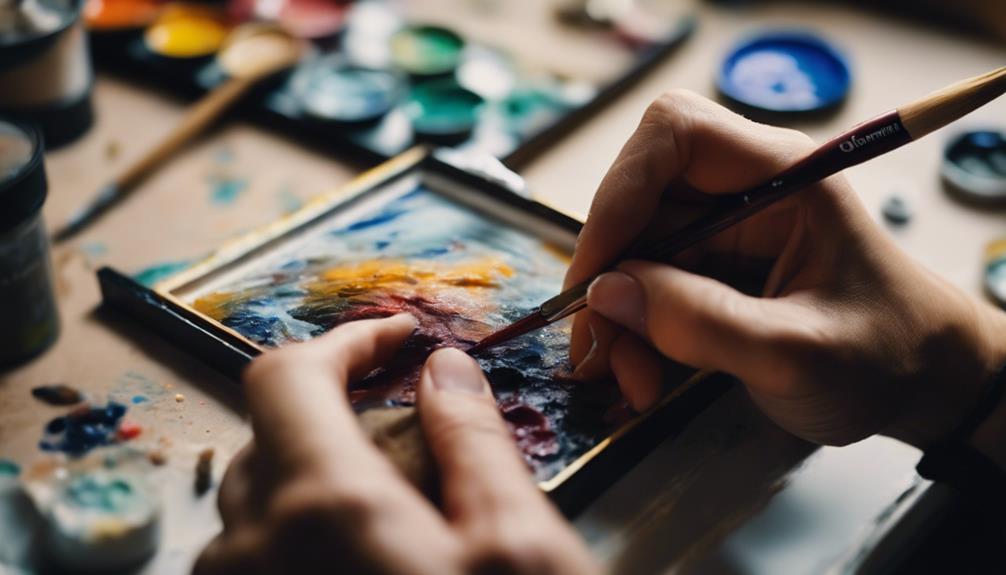
We often enhance the visual appeal of the painted plastic frame by adding intricate designs or patterns using acrylic craft paint on rubber stamps for a personalized touch.
To add that extra flair, here are some tips for detailing your plastic frame:
- Create Stencils: Make stencils from contact paper or use pre-made ones to easily incorporate decorative elements onto the frame.
- Antiqued Look: Apply acrylic paint or tinted glaze to achieve a vintage appearance, enhancing the frame's visual appeal.
- Metallic Touch: Experiment with gold or silver glaze for an elegant and luxurious finish.
- Creative Touches: Utilize stamps, painted designs, or rubbed-on color to elevate the overall aesthetic of the frame.
Sealing With Polyurethane
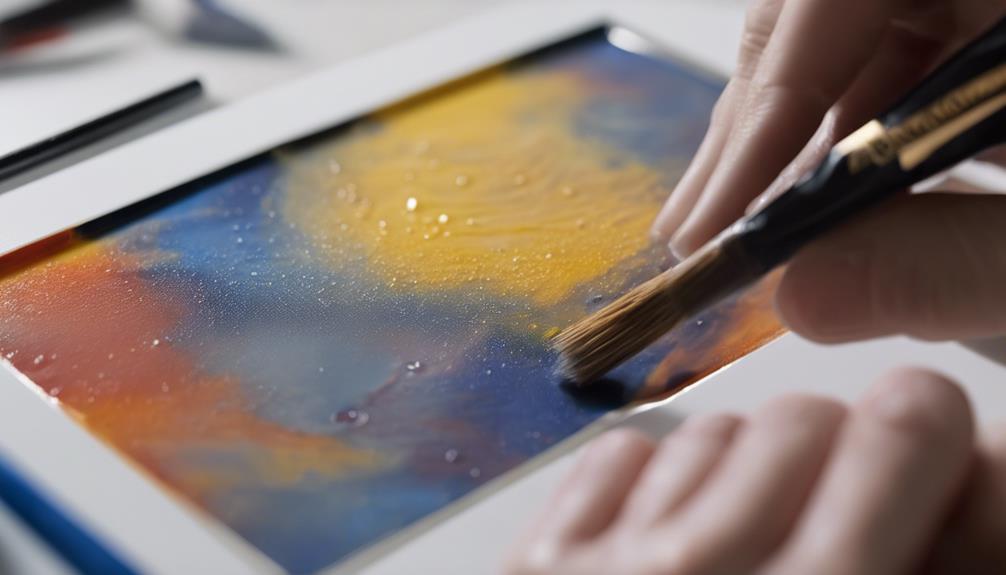
To protect and enhance the painted plastic frame, we recommend sealing it with polyurethane, a clear and durable sealant. Applying polyurethane over the painted surface not only provides protection against scratches, moisture, and UV rays but also helps to prolong the lifespan of the paint.
When selecting polyurethane, consider the different finishes available, such as matte, satin, semi-gloss, or glossy, to achieve the desired look for your frames.
To apply polyurethane effectively, make sure that the painted plastic frame has already received a coat of primer and is completely dry. Use a high-quality brush or foam applicator to apply thin and smooth coats of polyurethane to avoid streaks or bubbles. Allow each coat to dry thoroughly before adding additional layers.
Frequently Asked Questions
How to Paint a Plastic Frame?
When painting a plastic frame, proper preparation is essential. Sand the surface lightly and clean it with rubbing alcohol for better adhesion. Use a primer specifically formulated for plastic to make sure the paint sticks well.
Apply multiple thin coats of paint, allowing each layer to dry completely before adding more. Consider adding unique touches like stamps or antiquing for a personalized look.
Following these steps will result in a beautifully painted plastic frame.
What Paint to Use on Plastic Frames?
When painting plastic frames, it's important to select the right type of paint for excellent adhesion and durability. Utilizing paints specifically formulated for plastics guarantees a lasting finish.
Look for spray paints or brush-on craft paints labeled for plastic use. Consider using a plastic primer if the desired color is unavailable in the chosen paint type.
Adhering to these guidelines guarantees a successful painting project with vibrant and long-lasting results.
What Kind of Paint Will Stick to Plastic?
When considering what kind of paint will stick to plastic, it's important to choose a paint specifically designed for plastic surfaces. Regular brush-on or spray-on paints may not adhere well, leading to peeling or chipping.
Opt for spray paint formulated for plastic or use a plastic primer before painting to guarantee better adhesion. Acrylic craft paint can also be suitable for decorative purposes, but for a long-lasting finish, selecting the right plastic-specific paint is essential.
How Do You Prep Plastic for Paint?
When prepping plastic for paint, we must start by thoroughly cleaning the surface to remove any debris.
Light sanding helps the paint adhere better, and wiping with rubbing alcohol guarantees a clean canvas for painting.
Masking off areas we don't want to paint is vital.
Applying a suitable primer designed for plastic promotes paint adhesion and a smooth finish.
These steps are essential to achieve a professional-looking paint job on plastic surfaces.
Conclusion
In just 10 simple steps, you can transform a plain plastic frame into a personalized work of art.
By following these easy instructions, you can create a unique and custom piece that reflects your style and creativity.
So grab your supplies and get painting – the possibilities are endless!
- About the Author
- Latest Posts
Introducing Ron, the home decor aficionado at ByRetreat, whose passion for creating beautiful and inviting spaces is at the heart of his work. With his deep knowledge of home decor and his innate sense of style, Ron brings a wealth of expertise and a keen eye for detail to the ByRetreat team.
Ron’s love for home decor goes beyond aesthetics; he understands that our surroundings play a significant role in our overall well-being and productivity. With this in mind, Ron is dedicated to transforming remote workspaces into havens of comfort, functionality, and beauty.
Decor
How to Paint a Mirror Like a Pro in 3 Easy Steps
Find out how to transform your mirror into a masterpiece with these three easy steps that will elevate your space instantly.

Painting a mirror like a pro is simple in three steps. First, clean and trace the frame, then prime with gesso. Apply paint from the edges in thin layers using quality brushes. Opt for enamel or acrylic paint, allowing thorough drying between coats. Finish with sealant for protection. This process guarantees a flawless, professional look that enhances any space with elegance and style. Mastering these steps will help create a polished finish that transforms your mirror into a work of art.
Key Takeaways
- Use high-quality enamel or acrylic paint for a professional finish.
- Apply thin, even layers starting from the edges.
- Allow each coat to dry completely before adding another.
- Finish with a sealant or varnish for protection and longevity.
- Focus on details and take your time for a polished result.
Prepare Mirror Frame
Let's begin by cleaning the mirror frame with a soft cloth and window cleaner to remove any dirt or residue. Make sure to use rubbing alcohol or vinegar for tougher areas, guaranteeing the surface is completely clean before starting the painting process.
Once clean, trace the area to be painted on the mirror frame using a white soluble pencil for precise painting boundaries. This step is essential in achieving a clean and professional look for your mirror project.
Next, seal the mirror frame with white gesso as a primer to prevent paint peeling and ensure long-lasting results. This will create a smooth surface for the paint to adhere to, enhancing the durability of your design.
Additionally, consider using makeup pencils, white crayons, or fabric pencils for tracing intricate designs on the mirror frame before painting to achieve a detailed and polished final look. Make sure to take your time during this preparation process to guarantee a high-quality finish for your mirror frame project.
Apply Paint Evenly

To guarantee a smooth and professional finish, apply the paint evenly on the mirror surface using a high-quality paintbrush.
Here are some key tips to help you achieve a flawless coat of paint on your mirror:
- Start painting from the edges: Begin by carefully painting along the edges of the mirror frame before moving towards the center. This method ensures a consistent application and helps prevent any uneven patches.
- Work in thin layers: Avoid applying thick coats of paint as this can lead to drips and streaks on the mirror surface. Instead, opt for multiple thin layers, allowing each coat to dry completely before adding another one.
- Use a steady hand: When applying the paint, maintain a light touch and steady hand to achieve an even finish. This technique helps in creating a uniform look across the entire mirror.
Achieve Professional Finish
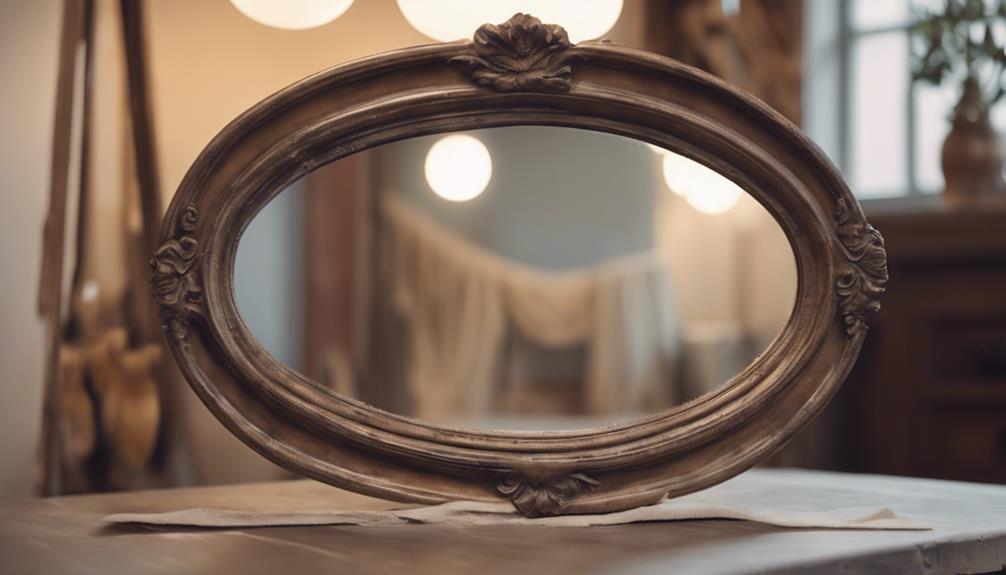
For a professional finish when painting a mirror, select high-quality enamel or acrylic paint specifically formulated for glass surfaces. To achieve a polished look, it is vital to apply thin coats of paint in even layers, allowing each coat to dry thoroughly before adding the next. This process guarantees a smooth and professional result on your painted mirror surface. Additionally, consider applying a sealant or varnish to protect the painted surface and enhance its longevity. Taking your time and paying attention to details will help you safeguard the painted surface and achieve a polished finish.
| Key Steps to Achieve Professional Finish |
|---|
| Choose high-quality enamel or acrylic paint designed for glass surfaces |
| Apply thin coats in even layers |
| Allow drying time between coats |
Frequently Asked Questions
How to Do Mirror Painting?
When tackling mirror painting, selecting the correct acrylic paint designed for glass surfaces is crucial. By seeking inspiration from TikTok artists, applying thin layers of paint, and ensuring each coat is dry before adding another, you can achieve a professional finish.
Seal the painted mirror with a varnish or sealant for durability. Experimenting with different painting styles and techniques is crucial for crafting a unique and creative mirror design.
How to Paint a Mirror to Look Vintage?
When aiming to paint a mirror for a vintage appearance, we recommend utilizing chalk paint for its ability to achieve a classic look.
Lightly sanding the frame before painting can enhance the vintage effect, while distressing techniques like dry brushing or layering can contribute to an aged appearance.
Consider applying dark wax or antiquing glaze to develop a vintage patina, resulting in a weathered finish that exudes a timeless charm.
How to Get Mirror Finish When Painting?
To achieve a mirror finish when painting, it's essential to use a high-quality mirror-specific paint. Make sure the mirror surface is thoroughly clean and free of any debris to prevent imperfections.
Apply thin, even coats of paint to avoid drips and streaks that can compromise the mirror-like appearance. Consider using spray paint for a more uniform finish and to prevent brush strokes.
Allow adequate drying time between coats for a flawless mirror-like finish.
How Do You Paint a Mirror Without Getting Paint on the Mirror?
When painting a mirror, we implement a meticulous approach to prevent any unwanted paint mishaps.
Careful preparation, like using painter's tape and paper to shield the mirror, is crucial. Selecting the appropriate paint type for the frame minimizes the risk of paint reaching the mirror.
Applying paint with precision and swiftly addressing any accidental spills on the mirror guarantees a flawless finish. Patience and attention to detail are key elements in achieving a polished result.
Conclusion
To sum up, painting a mirror like a pro may seem simple, but achieving that flawless finish requires attention to detail and patience.
So next time you pick up that paintbrush, remember to take your time and follow these steps carefully.
And who knows, maybe your mirror will reflect not just your image, but also your newfound painting skills.
Happy painting!
- About the Author
- Latest Posts
Introducing Ron, the home decor aficionado at ByRetreat, whose passion for creating beautiful and inviting spaces is at the heart of his work. With his deep knowledge of home decor and his innate sense of style, Ron brings a wealth of expertise and a keen eye for detail to the ByRetreat team.
Ron’s love for home decor goes beyond aesthetics; he understands that our surroundings play a significant role in our overall well-being and productivity. With this in mind, Ron is dedicated to transforming remote workspaces into havens of comfort, functionality, and beauty.
-

 Vetted3 weeks ago
Vetted3 weeks ago15 Best Contact Paper for Kitchen Cabinets to Elevate Your Home Decor
-

 Vetted2 weeks ago
Vetted2 weeks ago15 Best Poe Cameras for Home Security – Reviews & Buying Guide
-

 Vetted4 weeks ago
Vetted4 weeks ago15 Best Leather Restorer Products to Revive Your Furniture and Accessories
-

 Vetted3 weeks ago
Vetted3 weeks ago15 Best Drain Snakes to Unclog Your Pipes Like a Pro
-

 Beginners Guides4 days ago
Beginners Guides4 days agoI Inhaled Vinegar Fumes
-

 Vetted4 weeks ago
Vetted4 weeks ago14 Best Stationery Brands for Your Next Writing Adventure
-

 Beginners Guides2 weeks ago
Beginners Guides2 weeks agoSwinger Porch Light Color
-

 Mardi Gras Decoration3 weeks ago
Mardi Gras Decoration3 weeks agoWhy Does Hobby Lobby Not Do Mardi Gras?

























